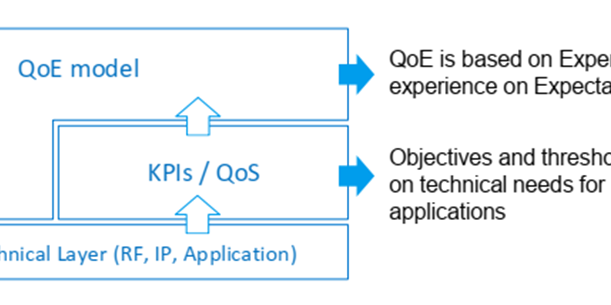5G is a promising stage in the evolution of mobile networks, which will bring us unfathomable opportunities in all areas, from entertainment to medicine. However, to ensure a perfect user experience, it is very important to test and optimize QoS and QoE parameters. As 5G supports various usage scenarios such as PPDR, autonomous cars, virtual reality, etc., the need for guaranteed quality of service becomes critical. QoS in 5G networks includes the next parameters.
- Latency: Time of data transfer between sender and receiver.
- Bandwidth: Maximum data transfer rate.
- Packet Loss: The percentage of packets that did not reach the recipient.
- Jitter: Variations in packet delays.
In the context of 5G, QoS also covers guaranteed quality of service for various use scenarios such as IoT, autonomous cars and VR.
QoE reflects user experience. This is not just user satisfaction, but a comprehensive indicator that includes:
- User satisfaction: Evaluation of the experience of using the service.
- Perception of quality: User assessment of service quality.
- Adaptability: The speed of network adaptation to changing conditions.
- Reliability: Stability of the connection.
- Intuitiveness: Ease of use of applications and services.
Relationships between QoE, QoS, KPIs is represented below.

Thus, the guarantee of high quality of 5G Network Applications requires careful testing and optimization. For this specialized equipment and software tools have to be used.
Test scenarios development includes creation of scenarios that reflect real usage conditions.
5GASP aims to emulate near real-world conditions to study the impact on QoS and QoE.
For these purpose was developed the lists of predefined test cases, which can be used for the Remote human driving NetApp. In each of 5GASP test case list, the well-defined fields are expected as follows. Some other fields (e.g., Expected Value) could be added and defined by the test designer.
- Test Case Name – the name of the test case
- Test Description – the detailed description of the test case
- Test Points – the measurable technical check points during the testing
- Test Method – it should be either a) Automation or b) Manual. 5GASP aims to execute the testing automatically as much as possible.
- Test Format – it should be either a) testing scripts) or b) testing tool xxx). Hereby, xxx is a tool name, e.g., iPerf.
- Test Priority – it should be one of the low 4 priorities: (i) P0 basic test cases, (ii) P1 recommended test cases, (iii) P2 optional test cases, (iv) P3 conditional test cases.
The next table presents a template of QoS related test case list with the example value of the well-defined fields.
QoS related 5GASP cross-vertical service test cases for Remote Human Driving NetApp
| Test Description | Test Points | Expected Value | Test Method | Test Priority |
| Verify End-2-End Packet Data Rate of both Uplink and Downlink from the view of NetApp | End-2-End User Plane | 1. Uplink >50 Mbps 2. Downlink >100 Mbps | Automation | P1 |
| Verify End-2-End Packet Latency of both User Plane and Control Plane from the view of NetApp | End-2-End User Plane | 1. User Plane <4 ms 2. Control Plane <20 ms | Automation | P1 |
| Verify End-2-End Packet Loss of both Uplink and Downlink from the view of NetApp | End-2-End User Plane | 1. Uplink <0.025 % 2. Downlink <0.025 % | Automation | P1 |
| Verify End-2-End Packet Jitter of both User Plane and Control Plane from the view of NetApp | End-2-End User Plane | 1. User Plane <1 ms 2. Control Plane <10 ms | Automation | P1 |
| Verify End-2-End Frame Loss of both Uplink and Downlink from the view of NetApp | End-2-End User Plane | <50 frame skips per hour | Automation | P1 |
Performing the above tests will allow you to conduct a comprehensive analysis of network characteristics that affect the functionality of network applications, which in turn has an impact on the quality of the user experience. Therefore, QoS testing is clearly an integral part of the process of testing network applications for 5G.
Conclusion. 5G promises a revolution in mobile networks. With proper QoE and QoS testing, you can make sure that 5G is not just a promise, but a reality.
Developers and engineers continue to work on optimizing 5G networks, and our role as consumers is to constantly demand the highest quality of service. QoE and QoS testing is not only a technical process, but also the key to better understanding user needs and providing an ideal network experience.
The latest technologies, algorithms and tools come to our aid, which allow us to bring the testing process to a new level. Thanks to this, we can expect even faster, more reliable and efficient 5G networks in the future.


